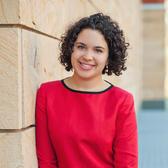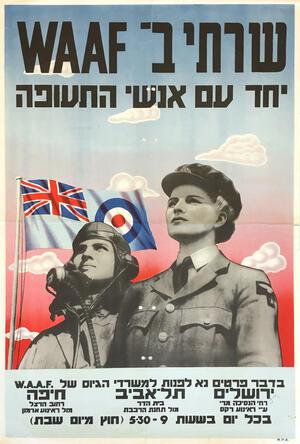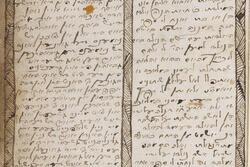From the Archive: WWII Women’s Auxiliary Air Force Recruitment Poster
Women’s Auxiliary Air Force Recruitment Poster, ca. 1943, courtesy of the Dobkin Family Collection of Feminism, via Posen Library.
What We Found
Take a look at this poster of a woman in military garb. Her uniform indicates her military service in World War II, but the text, surprisingly, is in Hebrew. In 1943, there was no State of Israel. The poster reads: “Serve in the WAAF with the men who fly.” WAAF stands for Women’s Auxiliary Air Force, an all-female World War II-era unit within Britain’s Royal Air Force. Colored in the red, white, and blue of the Union Jack, this poster is seemingly a Hebrew translation of similar English language posters that would have been found elsewhere in the British Empire during the war, such as in Australia or New Zealand. Why Hebrew? To recruit Jewish women in Mandate Palestine. But this poster is also different from other British posters in another way: This one informs women that they can come to one of three recruitment offices, any day but the Sabbath. And if we look closer, this rare version, featured in The Posen Library of Jewish Culture and Civilization, points to a bigger story about the Jewish women recruited into the British Military from Mandate Palestine.
Why It Matters
Many Jewish women volunteered for the British Air Force from Palestine. Most came from European countries overrun by Nazi Germany, and they were eager to fight the enemy murdering Jewish civilians.
A small number of Jewish women and men were selected for the British military’s Special Operations Executive (SOE) through the group Jewish Parachutists of Mandate Palestine. These parachutists gathered intelligence and organized rescue and resistance missions in Nazi-occupied territories in Europe. The Jewish recruits were particularly valuable because they knew European languages and were familiar with the areas and communities in occupied territories. Of the 250 people who volunteered, 110 were trained, only a third of whom parachuted into Europe.
Among this elite group is probably the most famous Jewish woman who fought in the resistance during the Holocaust: Hannah Szenes. The Hungarian-born Hebrew poet joined the British service shortly after immigrating to Palestine around 1939. She trained with the SOE and parachuted into occupied Hungary in 1944. Not long after she went behind enemy lines, Szenes was captured, tortured, and eventually executed at the age of 23.
Another well-known woman in this unit was Haviva Reik, 30, who parachuted into Slovakia in order to aid local Jews during the Slovakian national uprising of October 1944. She, too, was captured by the Germans and executed, as were a total of seven of the twelve parachutists whom the Nazis captured.
Many other women fought in the resistance and, like Szenes, volunteered to serve with the British. Jewish women in Palestine were recruited first into the Auxiliary Territorial Service (ATS) and then later into the WAAF. In total, roughly 3,600 Jewish women volunteered for the British military to serve in the Middle East. This was a significant, organized effort, with Jewish groups such as the Council of Women’s Organizations, Working Women’s Council, and the Jewish Agency also actively recruiting women into the British armed forces. Historian Anat Granit-Hacohen has shown that Jewish women’s recruitment into the British military caused some conflict in the yishuv (Jewish residents in Palestine). Some viewed women’s service as a threat to women’s role in society; others were more concerned that these women’s “anglicization” might threaten the Zionist project. Nevertheless, in a newspaper notice from 1941, when the British announced that they would recruit women, the Jewish Agency co-signed it and called on readers not to “undercut the role of the Hebrew woman in the war of fate.”
This context can help us imagine how women who saw this poster in 1943 might have viewed the decision to volunteer, if they were to come across it on a street corner or in a newspaper. By 1943, World War II would have indeed seemed like a “war of fate,” both for Jews in the Middle East and in Europe. The gravity of this situation is on display in the stories of volunteers like Reik and Szenes. But the enormity of the historical moment registers in the thousands of women who volunteered to serve on military bases. Their roles ranged from folding parachutes to shopkeeping, repairing equipment, and operating switchboards and radar stations.
This poster powerfully evokes Jewish women’s roles as resistance fighters, an aspect of Holocaust history that is less often told. It reminds us of the Jewish women who escaped Europe and courageously chose to return and fight. Their stories illuminate important dimensions of the history of World War II and of world Jewry during the Holocaust.
Learn More
Hannah Szenes is now one of the most widely known modern Hebrew-language poets. Some of her work has been set to music. Her poem, “A Walk to Caesaria” (commonly known by it’s first line as “eli, eli” / “my god, my god”) is often sung in Holocaust remembrance ceremonies and has been included in Reform, Reconstructionist, and Conservative prayer books. Her short powerful poem, “Blessed is the Match,” can be found on the Posen Digital Library.
This post is part of JWA’s From the Archive column. It was written in partnership with The Posen Library of Jewish Culture and Civilization.










My mother was one of the 3,600 women. She left Dresden, Germany, in 1936 and found her way to Palestine through the Jewish Youth Camps. Three sisters and her parents stayed in Germany and were murdered in, best guess, 1940. She told me she was stationed in Cairo, as best as I can recall. But, she never talked about her experience. She has been gone for almost 35 years, but I would very much like to learn more about what she experienced.
An aspect of Jewish Women's history I did not know. My mother joined the U.S.WAAC, Women's Auxiliary Army Corps in 1942, when it began, before it became the Women's Army Corps.(WAC). Would be interesting to know how many Jewish women served in those earlier days in the U.S. WAAC.
Hannah Szenes' archive has recently been deposited at the National Library of Israel, where it will be catalogued and made available to the public in the near future.